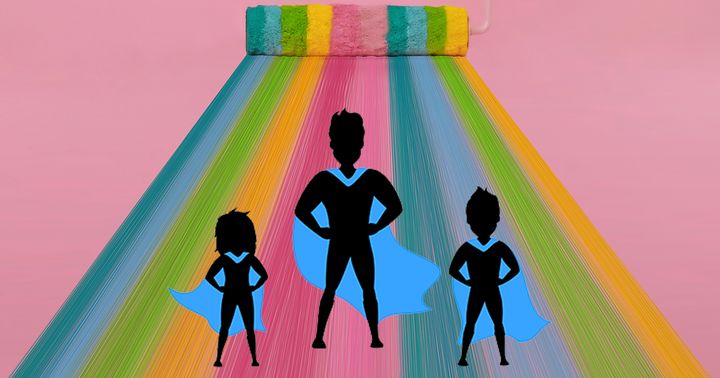If there’s one thing kids love (that is completely inescapable), it’s superheroes. From Go Jetters to Avengers, there are capes, mutant powers and flagrant defiances of gravity everywhere. They’re on film posters, the sides of buses, filling aisles in toyshops, and on TV – and children can’t get enough of them.
The good news for exhausted parents suffering superhero fatigue is that there might be a way to channel your offspring’s obsession into empathy, emotional intelligence and appreciation of the sacrifices other people make for them, according to a psychologist.
Dr Sam Wass, familiar to viewers of Channel 4’s The Secret Life of 4 (and 5 and 6) Year-Olds, says that, given time, these fictional characters help children develop a strong idea of heroism in everyday life.
“For young children, the idea of what is heroic is just a superhero, someone who is infinitely powerful or strong,” Wass tells HuffPost UK. “But, as children get older, they develop a more nuanced vision of what heroics in real life are. They realise heroism isn’t just about someone flying in and saving the world, but people making small sacrifices for others around them.”
So how can we help our kids along, and channel their superhero obsession into noticing these everyday heroic acts?

Captain Marvel and Aquaman are obviously a lot more glamorous than someone putting themselves out to do you a favour, but thinking about their attributes of self-sacrifice can increase children’s awareness of the positive behaviour going on around them, says Wass.
The psychologist has worked with Lego on its campaign to inspire children to dream of real-life heroes – in a study, they found some children noticed everyday heroes at young as six. ”One six-year-old said her parents were heroes for the sacrifices they have made for her,” Wass says.
Another child told a story of when she got lost and someone helped her find her parents again. One girl even identified herself as a hero, because she dropped a toy under her bed and even though it was really dark and she was scared, she reached in and pulled her toy out. “Recognising and acknowledging being scared, but facing it and doing it anyway – that’s absolutely what we’re trying to get at with the idea of heroism,” says Wass.
This awareness of every heroes should be encouraged, he says. One way to do that is through creative play: “Talking to your children as they’re playing, about what the characters in their games and scenarios are thinking and feeling, will encourage them to articulate what they think someone else will be experiencing,” he says. “That the firefighter going into a burning building might be scared, or the police officer chasing the burglar might be tired.”
Apply this same awareness into the real world, gently pointing out to children – who find it a lot easier to see things from their own perspective than someone else’s – where other people have made sacrifices for them. The more you can help them understand the challenges other people face, the more they will realise how many real-life heroes are out there already.
And of course, praising heroic acts in your child will reinforce that acts of bravery can happen on any scale – someone working in the police force is as brave as a child who conquers their fears of going to school. Giving the last bite of ice cream to their sibling means they’re a hero, too.
If you really want to relate to their superhero obsession – ask them what their favourite superhero would do in an everyday scenario. “Doing this encourages them to link stories that they hear with the real world,” says Wass.
Not every child is going to be convinced that their grandma spending the afternoon making them a cake is the same as Iron Man selflessly launching himself into space, but the two things have a lot in common – and acknowledging this will remind kids they’re surrounded by heroes all the time.
Grandma might look silly in the Iron Man suit though.